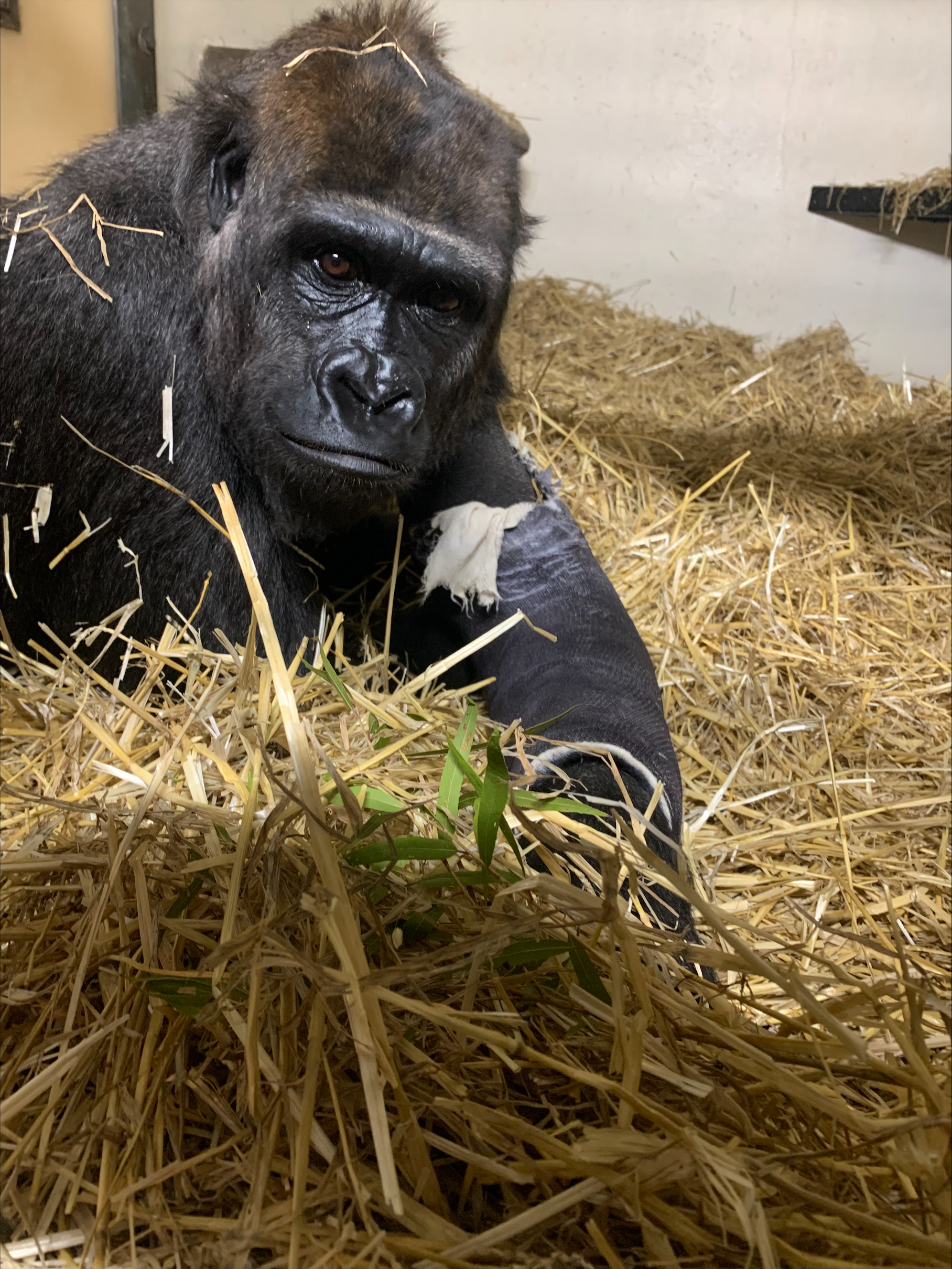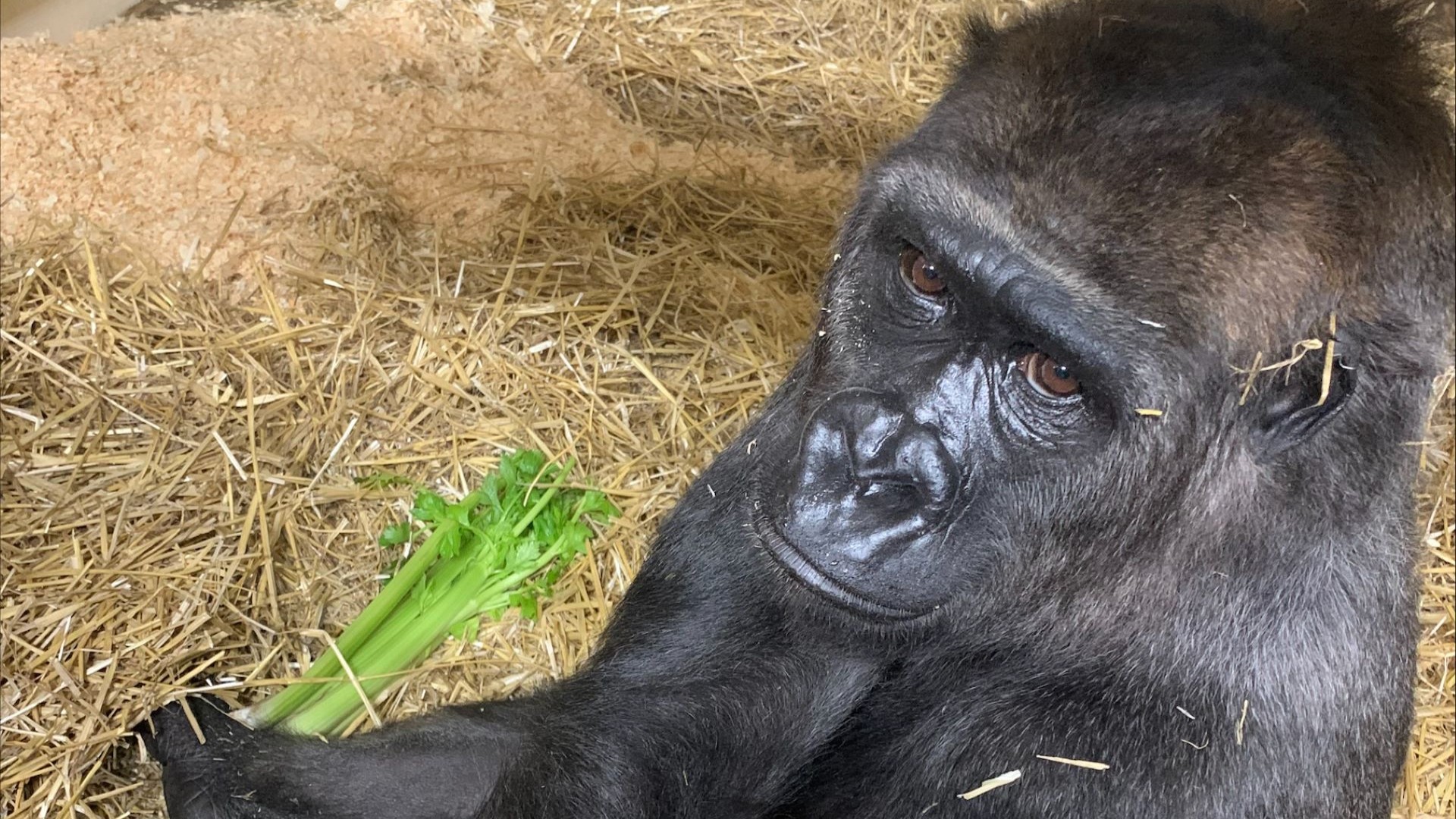It all started with what Shannon Morman calls a “gorilla girl fight.” Gladys, an 11-year-old female gorilla, had gotten into a scuffle with two of her siblings, as gorillas sometimes do, and ended up with a broken arm. Now, at around 4:30 p.m. on a Friday afternoon in mid-April, Morman was fielding a call from David Orban, director of animal science and strategy at the Cincinnati Zoo & Botanical Garden.
“It’s definitely one of the more interesting calls I’ve ever received in my career,” says Morman, who serves as a staff engineer for mechanical components at Colibrium Additive, a GE Aerospace company. “He sounded kind of anxious, saying, ‘Hey, we’re grasping at thin air here, but I thought maybe you guys could help us, since you have experience in printing metal components.’”
Orban explained the situation: Gladys had broken the distal humerus in her left arm, very close to the elbow, but the cast they’d initially put on was not strong enough. “So he was asking if we could print a stronger, metal version of a cast to keep her arm locked in place, because you can’t tell a gorilla to keep their arm still for 10 weeks while a bone heals,” says Morman.
The call didn’t come completely out of the blue. Morman had worked with Orban on another project for the zoo back in 2020, just before the pandemic shut the world down. That project involved using 3D printers to create metal feeders that resembled tree stumps to encourage better foraging habits in the zoo’s meerkat population. (The feeders were stocked with live crickets.) So she peppered him with questions: How big was Gladys? How big was her arm? How big would the cast have to be? Most important, she wondered if they could build the cast on one of the machines they had in-house.
Orban emailed a sketch of what he was thinking, including diameter and length estimates, and Morman jumped into gear. “He provided these dimensions and we were like, ‘OK, it’s feasible-ish. It’ll probably fit in the machine,’” she says. That was step one. Step two was calling her colleague Dave Bartosik, a senior manufacturing engineer, to explain the situation and ask if Colibrium Additive had any 3D printing machines available that week. Bartosik confirmed they did. Step three was calling Chris Schuppe, chief technology officer of Colibrium Additive — or, as Morman calls him, “my boss’s boss’s boss” — to find out if she had permission to work on this emergency project.
Printing a Cast in Less than Three Days
Once Schuppe cleared the project with legal and let Morman know she was OK to proceed, things moved fast. Morman and Bartosik hunkered down at a local microbrewery the next day to spitball ideas and make some preliminary sketches. Then, on Sunday, Schuppe and Bartosik went to the zoo to watch doctors from Cincinnati Children’s Hospital — the zoo had called them in to help — perform surgery on Gladys to stabilize the broken bone with plates and 19 screws.
“Once the surgeons were done, they came out and we asked them, ‘What are the requirements?’ Is it just fixing the arm from moving? Do we need to protect it? What are we trying to do here?” says Bartosik. The surgeons and zoo vets confirmed it was all of the above: stabilize Gladys’s arm so she couldn’t extend it and build a strong cast that she couldn’t destroy. Oh, and if the Colibrium Additive engineers could put holes in it for ventilation, that would be great, too. “They wanted to make sure we wouldn’t be trapping a bunch of sweaty gorilla arm inside this metal tube,” says Bartosik.

The two left with a temporary cast that the surgeons had made, a basic mold that they 3D-scanned to create a baseline for the additive model. Then, on Monday, Bartosik and Morman sat down with Chris Bryant, advanced lead designer at Colibrium Additive. “He’s an expert at making 3D models,” says Morman. It would be Bryant’s job to take all the information the team had gathered, plug the coordinates into his computer, and design the metal cast. They settled on a clamshell design, fastened with hose clamps, that would allow the zoo’s veterinary staff to put the cast on or take it off with relative ease. But they still didn’t have a solid gauge of Gladys’s strength. This was a sticking point, because it would determine the thickness and weight of the cast.
“We were really having to guess at strengths,” says Bryant. “When we asked them how strong she might be, they’d say ‘Eight times as strong as a human.’ OK, how strong is a human? ‘We don’t know.’”
Ultimately, they erred on the side of caution. “We just said, ‘We’re going to make it really thick,’” Bryant adds.
It took him about five hours to finalize the design. When they shared it with Orban and his team at the zoo later that day, the feedback was quick and specific: They loved the holes, the clamps, and the ingenious clamshell, which split the cast into two mirror-image pieces. Their main concern was making sure a few edges would be rounded off so that nothing could irritate Gladys’s skin. Bryant made the design adjustments while Bartosik prepped an electron-beam 3D printing machine. They used recycled titanium powder — Ti64, an alloy made up of titanium, aluminum, and vanadium, which is stronger than pure titanium. Ultimately, it took 65 hours to print.
Sparks Fly as the Cast Is Attached
By the time the cast was buffed and polished, it resembled a piece of intricately designed armor that would make a samurai warrior jealous. It was bent at a roughly 80-degree angle with a built-in gusset — a diagonal piece that joins the forearm to the upper arm at the crook of the elbow — to serve as an extra bit of structural insurance to keep Gladys from straightening her arm. Recessed channels — two on the upper arm and three on the forearm — allowed the hose clamps to be loosened or tightened as needed. Randomly spaced holes speckled the surface, small enough to keep Gladys from working her fingers into them. The whole thing weighed only eight pounds.
“That really highlights one of the benefits of additive: speed,” says Morman. “You can make a custom cast [using traditional manufacturing methods] for a gorilla. But can you make it in three days? Probably not.”
On Friday, April 19, less than a week after Orban first called, Schuppe, Bartosik, Morman, and Dan Frydryk, a senior engineering manager at Colibrium Additive, went back to the Cincinnati Zoo with the finished cast in hand. They watched as the zoo vet staff and doctors from Cincinnati Children’s Hospital removed Gladys’s temporary cast and fitted the new titanium one around her arm. Little did Bartosik know that this would be his big moment.
“When it was time to actually bolt everything together, they were like, ‘Sorry, you need to come in here and do it,’” he recalls. “I thought, Oh, that’s cool!” Luckily he’d brought a backpack full of tools, just in case. Once the clamps were secured, he had to use an electric saw to cut the long ends off the bolts. Gladys slept soundly as sparks flew.
Says Bartosik: “It’s the most steampunk thing I’ve ever done.”
In the weeks since, veterinarians at the zoo have temporarily removed what they call “the world’s first 3D-printed titanium cast” at least once to x-ray the arm and see how it was healing. (“She’s been locomoting comfortably, adapting her movements to the cast carefully and safely,” Victoria McGee, the Cincinnati Zoo’s zoological manager for primates, told People in mid-May.) When the titanium cast was finally removed for good on June 12, the vets saw “really good improvement” in the range of motion of Gladys’s arm. Now she will complete a regimen of physical therapy before rejoining her troop.
Looking back, Morman marvels at the timing, as well as David Orban’s good memory. “When I was there [that Friday], I asked him, ‘How did you even remember my name from four years ago?’” she says. “And he said he dug through a bunch of emails and was like, ‘You were my last hope.’”
